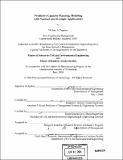Predictive capacity planning modeling with tactical and strategic applications
Author(s)
Zeppieri, Michael A. (Michael Anthony), 1975-
DownloadFull printable version (12.73Mb)
Other Contributors
Leaders for Manufacturing Program.
Advisor
Stephen C. Graves and David Simchi-Levi.
Terms of use
Metadata
Show full item recordAbstract
The focus of my internship was the development of a predictive capacity planning model to characterize the storage requirements and space utilization for Amazon's Campbellsville (SDF) Fulfillment Center (FC). Amazon currently has a functional model that serves the purpose of capacity planning, but they were looking for something that would provide more insight into their storage requirements against various demand forecasts and time horizons. With a more comprehensive model in place, Amazon would then have the ability to initiate studies, with the intent of optimizing the key parameters of their capacity flow Amazon utilizes a fairly robust and complex software solution for allocating items to storage locations as it receives shipments from its network of manufacturers and distributors. Amazon designates its capacity storage areas as being Prime, Reserve or Random Stow. Prime storage locations are bins from which workers pick items to fulfill orders. Reserve storage consists of pallet locations from which workers replenish Prime bins. Random Stow is a special case form of storage not taken into consideration for the purposes of my internship. The algorithm that determines the capacity allocation for a particular item is driven by two key parameters. The first parameter Amazon refers to as Days of Cover, which serves as a cycle and safety stock control variable. The maximum Days of Cover setting dictates the quantity of a particular item allocated to Prime locations, with any remaining items in the shipment being sent to Reserve. The minimum Days of Cover serves as the trigger resulting in a replenishment move from Reserve to Prime. (cont.) The second parameter, designated as Velocity to Bin Type Mapping, associates Prime bin locations to item demand in terms of outbound cubic volume per week. Amazon's Campbellsville facility has three tiers of Prime storage: Library Deep. Case Flow and Pallet Prime, with each tier representing a larger physical bin size in terms of capacity. The Velocity to Bin Type mapping parameter essentially sets ranges of demand to each of the bin types, such that items are sent to the bin type matching their demand. Amazon's capacity constraints are seasonal, with the holiday season posing the greatest challenge in terms of having enough Prime locations to fulfill demand. Amazon currently has no means of predicting the effects on their capacity allocation when operators make adjustments to either Days of Cover or Velocity to Bin Type Mapping. While operators do have some degree of insight into the dynamics these parameters have on capacity allocation, they are unable to optimize capacity utilization. The challenge for my internship was to develop a model that would provide insight into the dynamics driving these system parameters. The scope of the internship was to convert a demand prediction based on Sales figures into a forecast on capacity storage requirements. The focus of my work centered on providing the logic flow to perform this conversion, driven by a model built using Microsoft Excel and driven by a series of Visual Basic macros ...
Description
Thesis (S.M.)--Massachusetts Institute of Technology, Dept. of Civil and Environmental Engineering; and, (M.B.A.)--Massachusetts Institute of Technology, Sloan School of Management; in conjunction with the Leaders for Manufacturing Program at MIT, 2004. Includes bibliographical references (p. 78).
Date issued
2004Department
Leaders for Manufacturing Program at MIT; Massachusetts Institute of Technology. Department of Civil and Environmental Engineering; Sloan School of ManagementPublisher
Massachusetts Institute of Technology
Keywords
Civil and Environmental Engineering., Sloan School of Management., Leaders for Manufacturing Program.